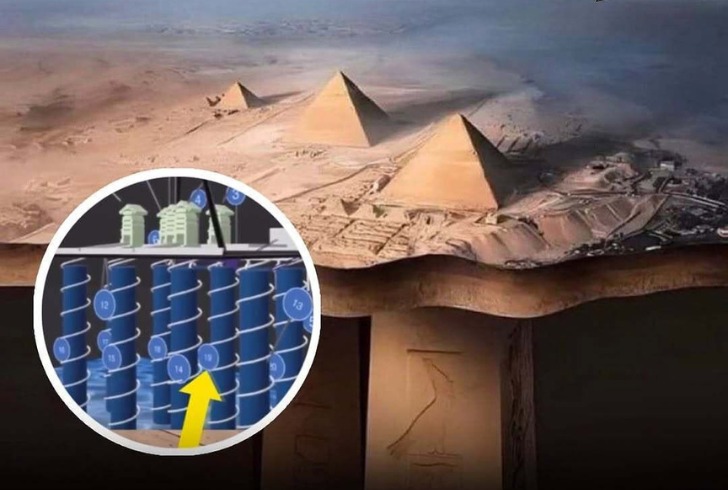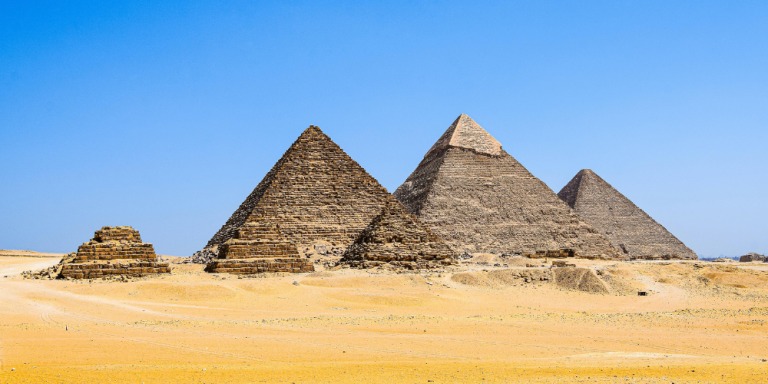A remarkable discovery beneath the Egyptian pyramids has captivated researchers and history enthusiasts alike. According to Italian scientists, an underground city might be hidden beneath the iconic Pyramids of Giza. If confirmed, this revelation could significantly alter the understanding of ancient Egyptian civilization.
Radar Technology Unveils an Underground Network
However, despite the excitement surrounding these findings, the study has not yet undergone peer review by independent experts. Many archaeologists remain skeptical, questioning whether the technology used can truly penetrate such depths.
Skepticism From Experts and the Need for Verification

While the discovery is groundbreaking, some experts argue that radar technology cannot reach such extreme depths. Professor Lawrence Conyers, a ground-penetrating radar specialist from the University of Denver, expressed serious doubts. He explained that while small underground chambers could exist, the idea of a fully developed subterranean city is highly exaggerated.
He also pointed out that many ancient cultures built significant structures over natural caverns. The Mayans, for instance, often constructed pyramids over caves with ceremonial significance. If a similar pattern existed in ancient Egypt, it might explain the mysterious underground formations.
Who Conducted the Study?
Notably, Malanga has previously been associated with UFO studies, raising further skepticism. However, Biondi is recognized for his expertise in radar technology, and Mei specializes in pre-dynastic Egyptology, adding credibility to the research.
Could This Discovery Change Ancient Egyptian History?
Some scholars have linked these findings to the legendary Halls of Amenti, an ancient Egyptian myth describing a hidden chamber of knowledge. However, without physical excavation, it remains unclear whether these structures exist as described.
What Makes the Pyramids of Giza So Mysterious?
1. Khufu’s Pyramid (The Great Pyramid) – The largest, standing at 480 feet tall, with a base width of 750 feet.
2. Khafre’s Pyramid – Slightly smaller but known for its intact limestone casing at the top.
3. Menkaure’s Pyramid – The smallest, yet still an impressive engineering feat.
For centuries, researchers have speculated that hidden chambers or tunnels could be concealed beneath these massive structures. This new study adds further intrigue to those theories.
How Was This Study Conducted?
According to Nicole Ciccolo, the study’s spokesperson, the radar detected cylinder-shaped structures arranged in parallel rows beneath each pyramid. Surrounding these formations, researchers identified spiral pathways that might serve as access points to a larger underground network.
Previous Research Supports the Possibility of Hidden Chambers

This is not the first time anomalies beneath the pyramids have been detected. In October 2022, Malanga and Biondi published a peer-reviewed study in the scientific journal Remote Sensing. Their research identified hidden ramps and chambers inside Khafre’s Pyramid, along with thermal anomalies near its base.
These findings align with earlier discoveries suggesting undocumented voids within the pyramids. Some archaeologists believe these empty spaces might contain burial chambers or storage areas, though no conclusive evidence has been found.
A Sensationalized Claim?
Professor Conyers emphasized that radar signals cannot accurately penetrate thousands of feet below ground. He suggested that only targeted excavations could verify whether the formations detected are man-made structures or natural geological formations.
What’s Next?
For now, the possibility of a hidden city beneath the pyramids remains an enticing mystery, capturing the world’s imagination and fueling ongoing debates among archaeologists and historians.
Even while modern technology continues to uncover previously undiscovered facets of Egypt’s history, on-site digs are the only way to validate these discoveries. In the meantime, the world observes as scientists work to uncover the ancient mysteries of the pyramids.
General Disclaimer: The information provided in this blog is for informational purposes only. Newlo Pedia makes no warranties regarding the accuracy or completeness of the content. Readers are advised to verify details independently before making decisions based on the information provided.
Content Disclaimer:This blog is intended to share general knowledge and insights. It is not meant to replace professional advice or guidance. Newlo Pedia does not endorse or guarantee the accuracy of any information presented here.
Advertising Disclaimer:This blog may include affiliate links or advertising content. Newlo Pedia may earn a commission from purchases made through these links, which helps support the platform. However, all opinions expressed are independent and based on our editorial standards.
Affiliate Disclosure:Some links in this blog may direct you to external websites, and Newlo Pedia may receive a commission for purchases made through these links. This does not influence the integrity or neutrality of the content provided.
Third-Party Links Disclaimer: This blog may contain links to third-party websites. Newlo Pedia does not assume responsibility for the accuracy, content, or policies of external websites. Readers are encouraged to review the terms and privacy policies of linked sites.
Legal Disclaimer: Newlo Pedia does not guarantee the safety, reliability, or quality of any products, services, or recommendations mentioned in this blog. Use any information or purchase products at your own discretion and risk.
Stock Image Disclaimer: Images featured in this blog are for illustrative purposes only. They may not reflect actual locations, products, or scenarios discussed in the content. These images are intended solely to enhance the reader’s experience.
Results Disclosure: The experiences or suggestions mentioned in this blog may vary from person to person. Outcomes are not guaranteed and depend on various factors, including individual preferences and circumstances.
Copyright Disclaimer: This content is the property of Newlo Pedia and is intended for personal use only. Redistribution or unauthorized use of this blog’s content is strictly prohibited.






